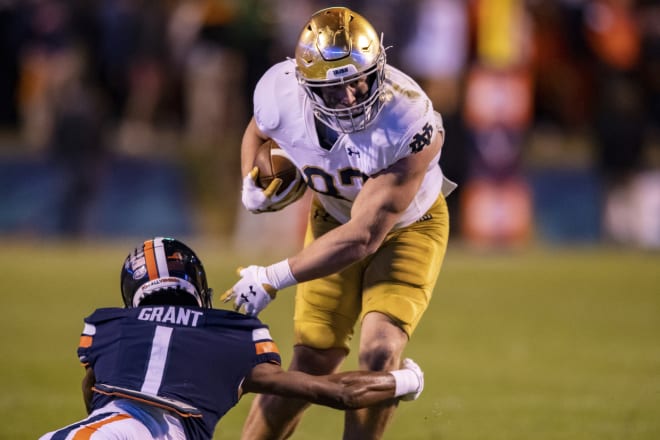How Notre Dame’s offense and defense have fared in the red zone
Notre Dame has a fluctuating relationship with the red zone.
The Irish’s defense clamps down when an opponent reaches it. Their offense, meanwhile, stalls there a bit more often than it would like.
Entering the season finale, Notre Dame ranked fourth nationally in red zone touchdown percentage. Opposing offenses have reached the end zone on just 13 of 37 trips inside the 20-yard line (35.14 percent). They are touchdown-less on their last seven red zone trips, which have resulted in just 12 points. Notre Dame’s defense has allowed zero or negative yards on the last four red zone possessions and scored one touchdown of its own.
On offense, meanwhile, the Irish are 62nd in touchdown rate (61.9 percent), with 26 touchdowns in 42 red zone possessions. They have reached the end zone seven of their last 10 times inside the 20-yard line, though. The efficiency is improving, but even amid it, some missteps have popped up. This was a sore spot in 2020 as well.
Notre Dame can head into the postseason — and perhaps the College Football Playoff with a few breaks — knowing it has a weapon in its red zone defense, no matter the strength of the opposing offense.
That opponent will, though, assuredly field a more potent attack than Navy, Stanford, Georgia Tech with a backup quarterback or Virginia with a freshman quarterback. In turn, the Irish’s own offense has to punch the ball in the end zone more often when the games inevitably become higher scoring.
How each red zone phase got here and the Irish’s tendencies inside the 20 are worth examining. On defense, the key is creating confusion.
“Red zone defense starts with not giving pre-snap reads to the quarterback,” Notre Dame head coach Brian Kelly said. “We’ve been really good and diligent in trying to change those pre-snap reads up. We’re going to show bracket [coverage], show zone and get into man, we’ll show man and get into bracket. It has been really good in terms of showing those looks.
“Before you can do that, you have to be able to stop the run. There have been many years where we’ve gotten into zone or bracket coverage and become very vulnerable to the run. We’ve been really good against the run and able to play double zone down there. That has been the difference so far this year.”
On cue, Notre Dame has a 29.9 percent run stuff rate in the red zone, which ranks 27th nationally. The Irish have also recorded seven red zone sacks since allowing their last touchdown in that area.
As Kelly hinted, taking away the run in the red zone leads to a one-dimensional opposing offense that’s easier to defend. Notre Dame is allowing a 36.6 completion percentage and 2.3 yards per pass attempt inside the 20, both of which rank third-best in the Football Bowl Subdivision. The Irish have two red zone interceptions and two forced fumbles.
“You have to be a little more aggressive down there, and we are,” Kelly said. “But you can’t be so predictable that when you get down there, you know what you’re getting. I think there’s been a fine balance.”
On offense, Notre Dame has tried to balance aggression and getting the ball to its best players in recent weeks. Since Oct. 9, junior running back Kyren Williams has 36 carries for 113 yards and eight touchdowns, along with seven receptions (two of them for receiving scores).
Sophomore tight end Michael Mayer had six red zone catches in the first seven games and a six-game streak without a touchdown, but caught two red zone passes and a touchdown Nov. 13 at Virginia.

Sometimes, red zone offense is as simple as feeding the best players the ball.
On its second drive at Virginia, Notre Dame faced a fourth-and-one at the Cavaliers’ 20-yard line. The Irish’s fourth-and-one quarterback sneak on the prior drive was stuffed. This time, they called one of their most reliable run plays and handed it to Williams. He gained 14 yards. Quarterback Jack Coan hit Mayer in the end zone one play later.
Later in the game, Coan connected with senior receiver Kevin Austin Jr. for a 15-yard touchdown on a fade route in the end zone. It was just Austin’s third red zone catch of the season, on seven targets. Finding a way to involve Notre Dame’s best jump-ball, contested-catch weapon more often down there would benefit the entire offense.“
"There are so many moving factors there,” Kelly said. “Some of it is play calling. Some of it is awareness of matchups and getting the ball to those guys who can make plays for you down there. I think we were searching for those guys. Then some of it is the quarterback.”
Extrapolate that 70 percent touchdown rate across 11 games, and it would rank 21st in the FBS. Even the best offenses have to kick field goals sometimes.
What they don’t do, though, is go backward. And the Irish backslid on two of those three non-touchdown possessions against Virginia and Georgia Tech. Freshman quarterback Tyler Buchner lost a fumble at the mesh point with freshman running back Logan Diggs on first-and-goal at Virginia. Notre Dame had first-and-goal at Georgia Tech’s 10-yard line on the game’s second play, but allowed sacks on two of the next three snaps.
There will be incompletions, run stuffs and defenses that take away Mayer or Williams on certain plays. but mistakes are more controllable.
“We’re aware we have to be a little more open in formations down there in the last month or so, and I think we have,” Kelly said. “We can’t just roll up our sleeves and say, ‘Hey, we’re going to be in three tight ends and stop our run. I think we’ve realized who we need to be down there.”

----
• Learn more about our print and digital publication, Blue & Gold Illustrated.
• Watch our videos and subscribe to our YouTube channel.
• Sign up for Blue & Gold's news alerts and daily newsletter.
• Subscribe to our podcast on Apple Podcasts.
• Follow us on Twitter: @BGINews, @MikeTSinger, @PatrickEngel_, @tbhorka, @GregLadky, and @ToddBurlage.
• Like us on Facebook.


